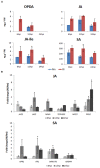Linking Jasmonic Acid to Grapevine Resistance against the Biotrophic Oomycete Plasmopara viticola
- PMID: 27200038
- PMCID: PMC4848468
- DOI: 10.3389/fpls.2016.00565
Linking Jasmonic Acid to Grapevine Resistance against the Biotrophic Oomycete Plasmopara viticola
Abstract
Plant resistance to biotrophic pathogens is classically believed to be mediated through salicylic acid (SA) signaling leading to hypersensitive response followed by the establishment of Systemic Acquired Resistance. Jasmonic acid (JA) signaling has extensively been associated to the defense against necrotrophic pathogens and insects inducing the accumulation of secondary metabolites and PR proteins. Moreover, it is believed that plants infected with biotrophic fungi suppress JA-mediated responses. However, recent evidences have shown that certain biotrophic fungal species also trigger the activation of JA-mediated responses, suggesting a new role for JA in the defense against fungal biotrophs. Plasmopara viticola is a biotrophic oomycete responsible for the grapevine downy mildew, one of the most important diseases in viticulture. In this perspective, we show recent evidences of JA participation in grapevine resistance against P. viticola, outlining the hypothesis of JA involvement in the establishment of an incompatible interaction with this biotroph. We also show that in the first hours after P. viticola inoculation the levels of OPDA, JA, JA-Ile, and SA increase together with an increase of expression of genes associated to JA and SA signaling pathways. Our data suggests that, on the first hours after P. viticola inoculation, JA signaling pathway is activated and the outcomes of JA-SA interactions may be tailored in the defense response against this biotrophic pathogen.
Keywords: Vitis vinifera; biotroph; downy mildew; jasmonic acid; salicylic acid.
Figures


Similar articles
-
Fatty Acid Desaturases: Uncovering Their Involvement in Grapevine Defence against Downy Mildew.Int J Mol Sci. 2021 May 22;22(11):5473. doi: 10.3390/ijms22115473. Int J Mol Sci. 2021. PMID: 34067363 Free PMC article.
-
Specific adjustments in grapevine leaf proteome discriminating resistant and susceptible grapevine genotypes to Plasmopara viticola.J Proteomics. 2017 Jan 30;152:48-57. doi: 10.1016/j.jprot.2016.10.012. Epub 2016 Oct 27. J Proteomics. 2017. PMID: 27989945
-
Strengthening Grapevine Resistance by Pseudomonas fluorescens PTA-CT2 Relies on Distinct Defense Pathways in Susceptible and Partially Resistant Genotypes to Downy Mildew and Gray Mold Diseases.Front Plant Sci. 2019 Sep 18;10:1112. doi: 10.3389/fpls.2019.01112. eCollection 2019. Front Plant Sci. 2019. PMID: 31620150 Free PMC article.
-
Plasmopara viticola the Causal Agent of Downy Mildew of Grapevine: From Its Taxonomy to Disease Management.Front Microbiol. 2022 May 11;13:889472. doi: 10.3389/fmicb.2022.889472. eCollection 2022. Front Microbiol. 2022. PMID: 35633680 Free PMC article. Review.
-
The Janus face of reactive oxygen species in resistance and susceptibility of plants to necrotrophic and biotrophic pathogens.Plant Physiol Biochem. 2012 Oct;59:37-43. doi: 10.1016/j.plaphy.2012.01.014. Epub 2012 Jan 25. Plant Physiol Biochem. 2012. PMID: 22321616 Review.
Cited by
-
Comparative de novo transcriptome profiles in Asparagus officinalis and A. kiusianus during the early stage of Phomopsis asparagi infection.Sci Rep. 2017 Jun 1;7(1):2608. doi: 10.1038/s41598-017-02566-7. Sci Rep. 2017. PMID: 28572584 Free PMC article.
-
Sucrose transporters of resistant grapevine are involved in stress resistance.Plant Mol Biol. 2019 May;100(1-2):111-132. doi: 10.1007/s11103-019-00847-5. Epub 2019 Feb 26. Plant Mol Biol. 2019. PMID: 30806883
-
Revisiting Vitis vinifera Subtilase Gene Family: A Possible Role in Grapevine Resistance against Plasmopara viticola.Front Plant Sci. 2016 Nov 25;7:1783. doi: 10.3389/fpls.2016.01783. eCollection 2016. Front Plant Sci. 2016. PMID: 27933087 Free PMC article.
-
A first insight into the involvement of phytohormones pathways in coffee resistance and susceptibility to Colletotrichum kahawae.PLoS One. 2017 May 19;12(5):e0178159. doi: 10.1371/journal.pone.0178159. eCollection 2017. PLoS One. 2017. PMID: 28542545 Free PMC article.
-
Fatty Acid Desaturases: Uncovering Their Involvement in Grapevine Defence against Downy Mildew.Int J Mol Sci. 2021 May 22;22(11):5473. doi: 10.3390/ijms22115473. Int J Mol Sci. 2021. PMID: 34067363 Free PMC article.
References
-
- Akkurt M., Welter L., Maul E., Topfer R., Zyprian E. (2007). Development of SCAR markers linked to powdery mildew (Uncinula necator) resistance in grapevine (Vitis vinifera L. and Vitis sp.). Mol. Breed. 29 103–111. 10.1007/s11032-006-9047-9 - DOI
-
- Anonymous. (2000). Description List of Varieties–Grapes 2000. Hannover: Landburg Verlag.
LinkOut - more resources
Full Text Sources
Other Literature Sources
Research Materials

